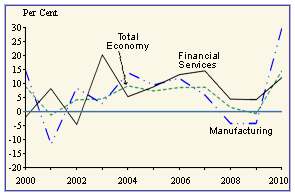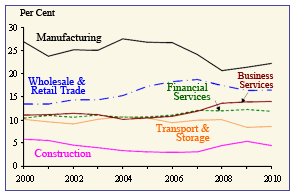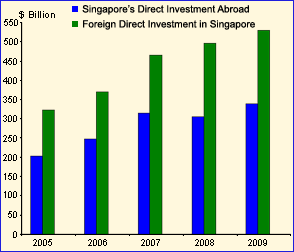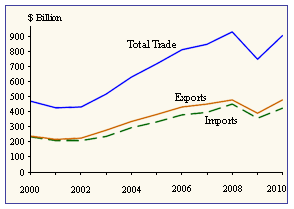Executive Summary
Singapore was a British trading colony since 1819 until its eventual independence in 1965. Singapore’s strategic location along trading lines worked well towards making the country one of the prosperous economy with strong international trading links. Apart from its location, Singapore’s political system and legal framework is attractive to investors. Foreign investment and trade drive the country’s economy.
Singapore has a competitive open market owing to many Free Trade Agreements. The country’s good infrastructure, high skilled labour, and zero corruption tolerance are all impetus for Singapore’s development as an economic tiger in Southeast Asia. This paper, therefore, seeks to analyse Singapore’s suitability for business expansion.
Country Profile
Geography
The Republic of Singapore is an archipelago of islands situated between Malaysia and Indonesia in South East Asia. Singapore Republic constitutes an archipelago of 63 islands inclusive of Singapore mainland officially known as Pulau Ujong, but commonly referred to as Singapore Island (Bureau of East Asian and Pacific Affairs, 2010).
Singapore is a small country measuring approximately 692.7 square kilometres landmass, slightly larger than 3.5 times the area of Washington, D.C. (Bureau of East Asian and Pacific Affairs, 2010).
Singapore has a coastline of 193 kilometres with zero kilometres land boundaries. Singapore has a gentle terrain making the country undulating central plateau. The country is linked to the main land through two significant manmade connectors linking Singapore to Joho, Malaysia (Bureau of East Asian and Pacific Affairs, 2010).
Singapore’s tropical location and the prevailing physical features therein mainly influence its climate. Tropical rainforest climatic conditions prevail in the country. The country experiences two distinct monsoon seasons (National Environment Agency, 2010).
Singapore is generally wet, hot and humid. The country records temperature ranges of 22 degree Celsius to 34 degrees Celsius and relative humidity ranges of 60% and 90% in the morning and evening respectively (National Environment Agency, 2010).
Demographics
The population of Singapore has over 40% of foreigners. According to the 2009 Population Trends, Singapore permanent residents were 3.73 million out of the country’s total population of 4.99 million (Department of Statistics, 2009a).
Singapore is densely populated, with a population density of 7,022 people per square kilometre (Department of Statistics, 2010a) and a population growth rate of 1.817% including immigrants (Department of Statistics, 2009a). Singapore’s population based on the 2000 Population Census had a racial make up of 76.8% Chinese, 13.9% Malay and 7.9% Indian.
In terms of age structure, 77% of Singaporeans is in the age category 15-64 years, 13.8 % in the category 0-14 years and 9.2% aged 65 years and above (Department of Statistics, 2000). The majority of Singaporeans live in urban centres all over the country.
Singapore’s population is generally healthy. Life expectancy in Singapore is remarkable high: 65 years for both men and women (Department of Statistics, 2010a). Infant mortality rate stands at 2.0 per1000 live births (Department of Statistics, 2010a).
Religion
Singaporeans have freedom of worship. Many religions exist in the country but Buddhism is the most preferred claiming 42.5% membership according to the 2000 census. Other widely practiced religions include Taoism, 8.5%, Islam 14.9%, Hinduism, 4%, Catholicism 4.8% and other Christianity 9.8% (Department of Statistics, 2000). However, a significant proportion of Singaporeans are non-believers.
Culture
Singapore is a culturally diverse country owing to high immigration rates. Singaporeans live and interact harmoniously irrespective of their racial backgrounds. Singapore’s culture portrays elements of influence from Chinese, Malay, Indian, and European cultures (Tan, 2007). Due to the high cultural mix in the country, there are no well defined culturally accepted behaviours.
Singaporeans perceive themselves as nationals of Singapore in spite of their racial or cultural background. However, elements of ethnicity are still distinct in Singapore. There are colourful cultural festivals significant to specific races, but still enjoyed by all Singaporeans.
Food comes in a variety of cuisines ranging from Malay, Chinese, Indonesia, India, Italian, Thai, western, French and Fusion (Bureau of East Asian and Pacific Affairs, 2010). Culture also influences food preparation in Singapore: Indian foods are spicier, Malay food has a taste of cocoanut, and Chinese food is less spicy, but mainly seafood (Bureau of East Asian and Pacific Affairs, 2010).
Political system
Governance
Singapore is a parliamentary republic. The country obtained its first constitution on June 3, 1959 prior to its independence on August 9, 1965. Since then, Singapore has amended its constitution twice, in 1965 and 1991. The constitution recognizes three arms of government: the executive, the legislative, and the judiciary.
The executive is made up of the president, the prime minister and the cabinet. Singaporean constitution vests the bulk of executive powers in the cabinet headed by the prime minister while the president’s office is ceremonial (Tan, 2007).
The legislative constitutes unicameral eighty-four member parliament consisting of elected members of parliament, nominated and non-constituency members. Whereas the president rules for a six-year term, the legislative have a five-year term.
Singapore’s political system is highly democratic. The country has a total of seven renown political parties including, People’s Action Party (PAP), Workers’ Party (WP), Singapore Democratic Party (SDP), Singapore people’s Party (SPP), National Solidarity Party (NSP), Singapore Democratic Alliance (SDA), and Reform Party (Bureau of East Asian and Pacific Affairs, 2010).
People’s Action Party is the most popular political and has won control of the legislative since the country’s independence in 1959 (Bureau of East Asian and Pacific Affairs, 2010).
The judiciary constitutes the High Court, Court of Appeal and subordinate courts.
Generally, Singapore’s political system encourages transparency and accountability. The country does not tolerate corruption and ranks high in terms of corruption index (Transparency International, 2009).
Legal Environment
Being a former British colony, Singapore’s legal system still has elements of British Westminster model, where there are three arms of government. The Parliament has legislative powers while the President retains the powers to assent to bills thus make the become law in the country.
Through assenting bills, the President remains in check of the legislative especially on bills with direct effect of the country’s financial resources. The Judiciary, on the other hand, has the powers to administer justice in the country. The Judiciary is made up of the Supreme Court, consisting of the High court and Court of Appeal, and Subordinate Courts.
Singapore’s law, as administered by the Judiciary, comes from two sources: legislation and common law. Whereas legislation is law legislated in parliament or other administrative bodies, common law is judgments delivered in courts.
Dispute resolution in Singapore takes various forms: litigation, mediation and arbitration (Hsu, 2009). Litigation involves dispute resolution in court. Singapore’s judicial system is fast and court cases take very short time. Mediation is another important avenue for dispute resolution in Singapore.
Singapore, through the Singapore Mediation Centre, settles disputes between parties who desire to find a genuine mutual agreement rather than seeking court ruling. Arbitration provides another avenue for dispute resolution. Arbitration is not common in Singapore, but should need arise the Singapore International Arbitration Centre has the capacity to solve disputes.
The judicial system has changed very much since independence. For instance, Singapore abolished trial by the jury and now has stiffer penalties including judicial corporal punishment and mandatory death penalties for some offences (Kuntz, 1994).
Business Legal Framework
Singapore is a destination for many investors. The country recognises the contribution of foreign investment in its economy. Singapore thus has an attractive legal framework that protects its investors, both locals and foreigners.
To achieve this, Singapore has signed many treaties with its trading partners to facilitate trade and direct foreign investment. Singapore has also amended its constitution through acts of parliament to provide appropriate legal framework for doing business.
Singapore also recognises the need to protect its consumers from exploitation and has legislated Fair Trade Act to protect consumers (Hsu, 2009). Singapore is also a party to several intellectual property treaties hence intellectual property is safe in Singaporean market (Hsu, 2009).
Competition Act
Singapore’s market is very competitive given the many investors in the country. Through Competition Act of 2004, Singapore has managed to provide a market pace that is free from unhealthy competition. The Act prohibits business practices that would otherwise restrict fair competition in the market.
Some of the practices prohibited by this Act include abusing market power, bid rigging, market sharing and price fixing. To implement this legislation, Singapore government requires that all businesses, including those outside Singapore but with affiliates in Singapore, comply with is law.
Free Trade Agreements
Singapore’s economy depends on foreign investment and trade. To facilitate this, Singapore has entered into various Free Trade Agreements with its trading partners.As a result, Singapore has amended most of its regulations to reflect the country’s commitment to treaties.
For instance, Singapore’s custom laws provide for preferential treatment in imports and issuance of certificates of origin to investors. Singapore is also a party to the WTOs plurilateral Government Procurement Agreement and offers an attractive procurement environment for its FTA partners.
Singapore industrial dispute settlement has also been amended to provide proper avenues for settling disputes with its trade partners. The country has committed itself to investor-State dispute settlement in its Free Trade Areas (Hsu, 2009).
Economic Analysis
Gross Domestic product
Singapore has a highly developed economy. The country’s location advantage along sea transport lines and its resourceful population are the main contributors to its success as economic tiger in South East Asia. At independence in 1965, Singapore was least developed owing to its small size and apparent lack of natural resources.
The country, however, directed its domestic investment to strategic state-corporations and developed economic policy frameworks that encouraged internal business, foreign investment and export (Lee, 2000), a strategy that explains Singapore’s current economic status. The average real growth rate for the period 1965-2009 stands at 7.9% (Department of Statistics, 2009b).
Singapore’s economy, however, suffered much from the acute respiratory outbreak in 2003 and the global financial crisis in 2008 and early 2009. The country’s GDP growth rate fell from 8.5% in 2007 to 1.5% in 2008. In 2009, Singapore recorded a growth rate of 3% (Department of Statistics, 2009b).
The gross domestic per capita was $ 182.23 billion translating to per capita income of $ 36, 537 for the year 2009 (Department of Statistics, 2009b). The economy has, however, recovered and recorded annual growth rate of 14.5% in 2010. Figure 1.0 shows real economic growth over a ten-year period.

Singapore’s economy is mainly driven by manufacturing and service sectors. In 2009, manufacturing and service industries accounted for 69.1% and 26.3% respectively of the country’s domestic product (Department of Statistics, 2009b).
Figure 1.1 represents GDP contribution by every sector of the industry during the year 2010. The main products manufactured in Singapore are biomedical products and electronics. According to the 2009 estimates, a biomedical account for 30.6% while electronics accounts for 20.8% of Singapore manufacturing output.

Foreign Investment
Singapore’s corrupt free political system, efficient infrastructure and skilled labour force have been the main impetus for foreign investment.
The country hosts approximately 7, 000 multinational corporations from Japan, United States and Europe (Department of Statistics, 2009b; Bureau of East Asian and Pacific Affairs, 2010). Singapore also hosts approximately 3000 companies from China and India. Foreign companies dominate manufacturing sector while state-linked companies run the service sector.
Apart from direct foreign investment, Singapore has also exploited options for investment abroad. Main destinations for Singaporean investors are China, United Kingdom, Malaysia, Hong Kong, Indonesia, Thailand, United States and Australia (Bureau of East Asian and Pacific Affairs, 2010).
Singapore has great concern for business ethics and social responsibility. However, the concept of corporate social responsibility is still new in Singapore and most locals are unaware.

Trade
Singapore is a free market economy. The country has entered into a number of Free Trade Agreements (FTAs) with various countries totalling to eighteen Free Trade Agreements. Some of Singapore’s trading partners include United States, Australia, China, Costa Rica, Malaysia, Hong Kong, Japan, and Indonesia among others.
Trade through imports and exports plays a significant role in Singapore’s economy. In 2009, total trade amounted to US dollars 513.9 billion with exports totalling US dollars 245 billion and imports, US dollars 269 billion (Department of Statistics, 2009b; Ministry of trade and Industry, 2009).
Figure 1.3 illustrates how Singapore performed in terms of trade over the past ten years. Singapore exports pharmaceuticals, food and beverages, chemicals, petroleum, electronics, transport equipment, and telecommunication devices to various countries including Malaysia, China, United States, Indonesia, and Hong Kong. In return, Singapore imports various products from its trade partners.

Resources availability
Singapore does not have any mineral resource. The country thus imports mineral resources including crude oil, iron and steel used as raw materials in its manufacturing sector.
In general, the only natural resource readily available in Singapore is water, but the country faces a great challenge in conserving water resources given the high rates of industrial pollution. Singapore also has a high potential for solar energy given its climatic conditions and tropical location.
Human Resources
Singapore boasts of a large pool of skilled labour force totalling to about 3.053 million by June 2010 (Department of Statistics, 2010b). The country focuses more on domestic labour force. Singapore also has foreign workers who are rather in the blue-collar jobs. The countries labour policy emphasizes the development of domestic labour force hence discourages employment of foreigners in white-collar positions.
The government also empowers its domestic labour force through provision of quality education that is skill development oriented (Ministry of Education, 1972). The government also focuses on continuous training and retaining of its domestic labour force (Trade Chakra, 2008).
The government has also put in place various legislations including Industrial Relations Act and Employment Act that emphasises collective bargaining and negotiation. Singapore’s workers are also among the best-remunerated labour force globally.
The national Wages Council, which consists of representatives from the government, employers and workers unions, ensures steady wage increase that reflects living conditions. In fact, Singapore’s labour force is among the most motivated employees in the world.
The labour force is organized into trade unions, but the government controls its labour force through labour regulations. Work values mainly reflect cultural values. Labour unrests are unheard of in Singapore, a characteristic that makes the country attractive for investors.
Labour force is highly flexible. Labour costs are relatively low. The country also has flexible work hours. Singapore government recognizes official working period of five days a week amounting to between 40 and 45 hours per week.
Singaporeans value shopping and you will always find the shopping malls jammed with consumers doing shopping as a pastime.
Risks of Investing in Singapore
Singapore’s economy is a free market economy with very competitive market. Currently, Singapore is a host to approximately 7,000 multinational corporations excluding domestic investors. Putting our firm’s money in such a competitive market might lead to unnecessary losses.
We will have to work extremely hard to compete in Singapore’s open market. Besides, Singapore’s economy depends on the economic activity in the global economy. Any global economic downturn affects the economy directly. For instance, the 2008 economic downturn experienced by most world economic tigers contributed to a negative growth rate in Singapore, even if the country did not experience the downturn directly.
Investing in Singapore will mean that we put our firm’s money to the risk of such global economic influence. However, through proper risk management strategy we can overcome these risks. Singapore has more potential for business development that we cannot ignore. In fact, the world bank has ranked Singapore as the country with the best business environment now for five tomes in a raw (Doing Business, 2010).
Conclusion and Recommendations
After a thorough analysis of Singapore, I can boldly conclude that Singapore has good potential for foreign investment. The country has good infrastructure and a business friendly environment that can be tapped into. Singapore’s openness to foreign investment also makes it a good destination. However, investors must be aware of the potential competition due to the high number of investors in Singapore.
Singapore’s economy is also depends on the global economy. Any global economic downturns affect the country directly. To this end, I propose the following recommendations as the business development manager. First, Singapore is a good destination for expanding our business.
We can exploit the opportunities available including political and economic stability, high-skilled labour, good legal framework and Australia-Singapore Free Trade Agreement to our advantage. Second, before we think of expanding our business in Singapore, there is a need to come up with proper risk management strategy to be able to handle any potential risk.
We must also consider the fact that Singapore is a free market economy and put in place sufficient measures to be able to compete in Singapore’s open market. However, Singapore has Competition Act that will be able to protect our business from unhealthy competition. Last, it would be cheaper for our business to export to Singapore than to open a branch in Singapore.
References
Bureau of East Asian and Pacific Affairs, 2010. ‘Background Note: Singapore’. U.S.: Department of State. Web.
Department of Statistics, 2000. Census of Population 2000. Singapore: Singapore Department Statistics.
Department of Statistics, 2009a. Population Trends 2009. Singapore: Department of Statistics. Web.
Department of Statistics, 2009b. ‘Key Annual Indicators. Singapore: Department of Statistics. Web.
Department of Statistics, 2010a. Census of Population 2010. Singapore: Department of Statistics. Web.
Department of Statistics, 2010b. ‘Key Annual Indicators. Singapore: Department of Statistics. Web.
Doing Business, 2010. Doing Business 2011: Making a Difference for Entrepreneurs. Web.
Hsu, L., 2009. FTA: Singapore Legal Developments. Singapore: Singapore Academy of Law.
Kuntz, T., 1994. Ideas and Trends; Beyond Singapore: Corporal Punishment, A to Z, The New York Times. Web.
Lee, K. Y., 2000. From Third World To First: The Singapore Story: 1965–2000. New York: HarperCollins.
Ministry of Education, 1972. Education in Singapore. Singapore: Educational publication bureau.
Ministry of trade and Industry, 2009. Economic Survey of Singapore 2009. Singapore: Ministry of Trade and Industry.
National Environment Agency, 2010. Weather Statistics. Singapore: Ministry of Environment and Water Resources.
Tan, K. P., 2007. Renaissance Singapore? Economy, Culture, and Politics. Singapore: NUS Press.
Trade Chakra, 2008. Business Excellence In Singapore. Trade Chakra. Web.
Transparency International, 2009. Corruption perception Index 2009. Belgium: Transparency International.